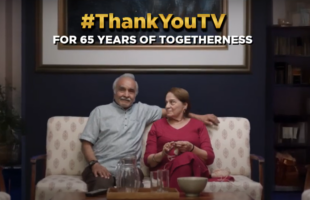the broadcasting industry in Asia is witnessing proactive production or re-purposing of content beyond TV, onto platforms such as mobile devices and PC’s to meet the needs of multi-platform consumption. While viewers are being presented with options to view content as full-length programmes; on-demand in short segments; or even to download personalized products, this means more competition but also wider distribution opportunities. Companies like MediaCorp TV, acknowledge that the focus is on churning out content for all platforms in an integrated and complementary manner. But still, the primary platform for production is television, as it remains the main revenue source of its business. “The other platforms are used to extend the lifespan or reach of our content. For instance, the Internet allows us to offer catch-up dramas to consumers on demand, while digital TV on buses provides commuters with updated news and information during transit,” says Ku Kay Mok, business development director (programming & production 5) MediaCorp TV. A company like Turner, which has been engaged in the digital environment since 1999, highlights that technology changes by the day. Some of the key considerations include the functionality of devices, delivery of technology and the service network. Owing to advancements, taking place from time to time, the involvement and development is a continuous process. “As content providers, there is a need for us to keep up and employ the new technology, and therefore on the R&D side, we work very closely with our own lab to test new delivery technologies. This will enable us to perfect our content and user experience before we launch new offerings in the market,” says Ringo Chan, VP, wireless, interactive content development and distribution, Asia Pacific for Turner Entertainment Networks Asia, Inc. (TENA). According to Chan, Cartoon Network’s multi-media strategy has started to pay off, with mobile content being widely distributed in more than 15 countries and territories in the Asia Pacific region. In addition to wireless content and linear broadcast, Turner aggressively pursues content aggregation across multiple platforms including interactive media, publishing, consumer products and promotional licensing – exploring all possible points of contact. Mark Eyers, executive director, content, TENA adds that when it comes to different markets the level of penetration of a certain medium can vary drastically. “For instance, in Taiwan both cable and online penetrations are very high. This, however, is not the case for Australia, where cable penetration is significantly lower than that of online. With this in mind, Cartoon Network’s strategies have always been flexible, so that we could take care of the different needs (of all our viewers),” said Eyers. Gregory Ho, VP and general manager – Animax Asia, SPE Networks – Asia agrees that the markets vary considerably across Asia. Some are far more evolved in being able to offer consumers viewing choices across multiple platforms while others are still in basic pay TV mode and trying to drive up subscription. “This is certainly one of the biggest challenges posed for media companies like ourselves as there isn’t a one size fit all,” said Ho, adding that new broadcasting platforms are the new wave for growth of the entire industry. “It represents new revenue opportunity for our existing channels such as Animax and AXN. For our new channels such as SET and Animax Mobile, it gives these channels another means to reach viewers differently.” Rob Gilby, senior vice president & managing director, Disney-ABC International Television (Asia Pacific) says being able to expand the reach of content to new platforms while being sensitive to cross-platform rights is an important consideration for any US distributor. “At the end of the day, it’s about finding the right home for our hit franchises and programming whether it be full-length episodes of Desperate Housewives or made-for-mobile short-form clips of LOST,” he points out. Gilby says his company takes a very strategic approach to digital platforms and partners, to consistently deliver the highest quality experience anywhere. “After our pioneering iTunes deal in the US (to make episodes of our series available for sale on Apple’s iTunes Stores) we were able to identify a set of criteria that can be applied to all our new media opportunities,” said Gilby. “These considerations include working with partners that: deliver a quality consumer experience; have a sound growth strategy based on delivering value to the consumer; put a priority on marketing and promotion; and who will value and protect our content.” In terms of challenges with production for varied platforms, developing content that is suitable for consumption is the key. “Since TV, mobile and PC have very distinct properties of their own, we believe the strategy for satisfying multi-platform needs is to create content specifically for cross-platform use instead of just reformatting full-length TV content to mobile and PC specifications. The other challenge is the different mindsets of each platform. Broadcasters, telcos and online portals often have very different views on the purpose of content and what kind of content they would like to acquire. The good news is that with the emergence of triple or quad-play strategies, content that works across various platforms is a great way to tie together such bundle deals,” said Rosemary Tan, executive director, mobile entertainment, Asia Pacific at Sony Pictures Television International. According to Tan, when creating cross-platform content, SPTI takes into account the latest trends on how users are interacting with these platforms. With the rise of “snacking” culture on mobile and online, short-form content seems to work best when it comes to original productions. “With both of our multi-platform shows, Afterworld and Gemini Division, we are making them available in a 3-5 minute format as well as a 30-minute version. As far as genres, our first two shows are sci-fi in theme as the genre naturally fits with a multi-platform format, but we don’t think multi-platform shows can only be limited to that genre. For example, our next series will be a horror comedy,” said Tan. In terms of how broadcasters’ responsibilities are evolving, Turner’s Eyers said, “Well, for once, we have started working closely with the legal department of the content producers. We are now on first name basis with everybody and have developed a vernacular understanding of the legal terms and conditions involving ‘rights’.” According to Eyers, given the different nature of all the platforms, the content planner needs to be sensitive and also very creative when it comes to programming, in order to fulfill viewers’ needs across the board. For instance, online content typically reaches a wider audience across a longer time period than traditional linear channels. Consumers can access content anytime and click on shows they want to watch. “This environment allows us to produce more niche programming, which means providing more content to all people. The recent strides in broadband technology have also made it possible for content providers to provide programs of all lengths online. Programming for linear channels, on the other hand, are tailored for an aggregate audience. With the emerging importance of multi-platform content delivery, it is imperative that content producers and we work closely,” said Eyers. Gilby sees all platforms as additive, not cannibalistic – all platforms create a virtuous cycle for the television industry and each continually drive current fans and new viewers back to the primary platform – television. His company is working with Apple iTunes in Australia to make TV series such as Grey’s Anatomy available for download the day after it airs on the Seven Network. Generally, movies are also available for purchase on the iTunes Stores in Australia and New Zealand. SPENA’s Ho feels various platforms offer an extended opportunity to entertain viewers. “Our multi-media multi-platform original HD animation production LaMB is an example of how we are trying to do so. Months before viewers see the movie, they will first encounter the LaMB universe on-line and then (on) mobile. Their introduction to LaMB begins online with an interactive website and on-air promotional activities would be designed to drive viewers to the website. Also prior to the movie broadcast, an overlapping mobile campaign will kick in comprising of a mobile graphic novel series that continues on from where the online series ended. There will also be mobile games and video mobisodes to download,” explained Ho. From Irdeto’s perspective, its senior VP, sales & marketing, Doug Lowther, said, “ Our experience has proven that operators can indeed improve ARPU and customer loyalty by offering customers a wider variety of services. PVR has been especially effective in achieving this – at one of our operators only three percent of PVR subscribers churn, while in the overall base the figure is more than 13 percent. PVR customers also generate an average 13 percent more revenue (which is high-margin because it does not require paying extra content costs). If this same benefit can be brought to new platforms like Mobile TV and the PC, then the overall impact will be even higher. This is especially important in times of increasing competition from new platform providers like IPTV.” The company has created various new security technologies that are specially tailored to each of these environments. “But we are also moving increasingly toward a universal software security approach for all platforms. To ensure that our security software provides superior protection, we have invested in Cloakware, a specialist in software robustness technologies, allowing us to do in software what others can only do in hardware,” said Lowther. The technological ability to provide PPV and even VOD/SVOD services have been around for a while now, but in the recent two years, there has been an increased focus by platforms, whether IPTV or cable, on these services as a competitive advantage and to reduce subscriber churn. For VOD/SVOD, regardless of whether delivered via IPTV or cable VOD platform, feature films and sports are driver content. For his part, Ho says, “We believe that entertainment especially Japanese anime is a genre, which has high potential for PP/SVOD/VOD services. This is because the average anime viewer is a very passionate and enthusiastic viewer eager to get the latest content.” However, he added, “ Ironically, the Japanese animation industry has been a laggard in embracing new media. We have however observed a shift in mindset in the last year or so and are now looking at creating such services in collaboration with Japanese anime studios and distributors.” On the same, Turner’s Chan said, “VOD platforms through cable and IPTV enables Turner, as a news and entertainment content provider to better serve our viewers at times convenient to them, deliver programs to very targeted demographic and retain eyeballs within the Turner’s branded environment. The effective approach that Turner employs is by creating a branded VOD service to serve the core viewers and attract new customers, develop creative window strategy between linear channel and VOD, offer eye-catching and interactive VOD user interface and implement targeted marketing/promotion programs with platform operators.” Gilby said VOD/SVOD is a model that is very attractive to the consumer as it offers them the convenience and flexibility. In a significant initiative for Disney-ABC in February this year, the company launched Stage 9 Digital Media, a digital media studio focused solely on producing original short-form content for mobile and broadband. The first series that the company has made available for mobile is Squeegees, an ensemble comedy about entrepreneurial slackers and their fledgling window washing business. So far the series has had over 1.5 million viewers on ABC.com in the US. Other new series available from Stage 9 include Voicemail 2, a follow-up to the ABC.com original series, Voicemail, about one man’s decade-long collection of phone messages, and Trenches, a sci-fi action thriller. On mobile video, Chan said, “From Turner’s perspective, we want to make our content available across all mobile TV platforms regardless of whether it is streaming or broadcasting. For instance, Cartoon Network programming is currently streaming to 3G and 3.5G subscriber to various carriers in Asia Pacific region in the form of 24/7 channel and animation shorts. The service is also broadcasting through DVBH in Philippines. However, at this stage, Turner is focusing more on streaming our TV services via 3G mainly because of the higher penetration of 3G subscribers in the region.” SPENA’s Ho said in the case of Mobile TV, the growth has perhaps not been as rapid as some might have hoped and this is probably because telcos themselves are going through an evolutionary process of moving from being just a single voice product company to being a media company. Ho said the current focus is on Animax Mobile, a 3G service currently available in HK, Taiwan and Brunei. The company is planning to make the service in two more markets in South East Asia in the near future, though the operators’ names were not shared. SPTI, according to Tan, is offering content for mobile users at various levels of mobile technology development. It is creating everything from themes, ring tones, mobile game and screensavers for 2G use to streaming channels and full-length movie downloads for 3 or 3.5G use. Going forward, MediaCorp TV’s Ku expects a gradual shift to original content production on other platforms as they gain traction. “We are hopeful about the potential of mobile TV in Singapore as majority of Singapore residents take public transport which translates to a higher need for such services on-the-move. Mobile TV can potentially drive the demand for original, interactive programmes as users are more likely to participate given the convenience of the form factor. As 3G videos have inherent scalability limitations, we expect it to remain a niche service even if it were to overcome the initial adoption hurdles. Consequently, our plan is to work with the local telcos on rolling out a mass market consumer mobile television service using DVB-H technology,” he said. Even as Ho admits that there is a potential for bigger distribution revenue, whether it is for TV, mobile or for IPTV, content producers, however, need to either gain greater expertise or acquire expertise that go beyond traditional TV content production ranging from gaming, web, mobile and even in the area of producing quality branded entertainment. Right now few, if any, have all these abilities.
Ad – Before Content
Related Articles
Publicis India unveils heartwarming “Thank You TV” campaign for ZEE TV
Sphere Abacus sells true crime feature documentary Murder & Madness: The Cult Conspiracy to Prime Video
Spingo Continues Global Push into the Americas as O4 Media Signs Option Agreements with LA-based 5X Media and Brazilian outfit LaReina Entertainment
Keshet boards Red Alert with producer Lawrence Bende
FIFTH SEASON inks strategic partnership with Front Street Pictures for TV movies slates
Taiwan Hosts Asian Animation Summit for the First Time Bringing Together Major Buyers Netflix and Warner Bros.







